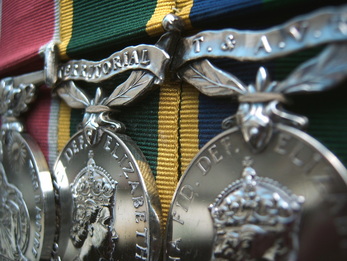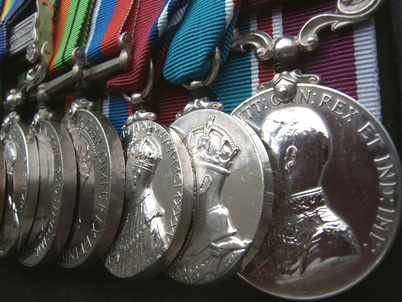Last Updated 26 Jul 24 - Latest updates: SMITH R W P, TRAVELL, WHITTAKER E.A, SODEN, PARKES, DURRAN James Levi and John Thomas, COOLING.

Welcome to my web site, I hope you find it of interest. It is being updated regularly so please look back in on a frequent basis.
My interest in collecting medals, or Ordecomedology, as it is unofficially known, began in the early 1970s when as an Air Cadet attending various parades during the year, Armistice Day, Battle of Britain and others I became intrigued by the colourful pieces of material hanging from men’s chests!
This inquisitiveness coupled with a visit to a friend’s house - who possessed a German award, the Der Guten Muter – aroused an interest that 40 odd years later has not died.
The initial interest led to the beginnings of a collection limited by the amount of pocket or paper round money available each week. It was a case of purchasing medals that looked nice, or were affordable with no particular theme. These were the days when most towns had ‘junk shops’ with windows or boxes full of medals on the counter, available for only a few pence and certainly within pocket money range. It was also many years before the ability to research awards thoroughly had become available and home computers and the internet had not even been conceived. People were also not so acutely aware of their personal family history and subjects like genealogy and the massive industry that grew around research was still to come.
It is also interesting to consider that in the mid 1970s there were still many men and women throughout the country having only recently retired who had fought in World War One. Those having fought in World War Two still being relative youngsters in their mid forties. The Great War Veterans would often be seen on local parades wearing their ‘Pip Squeak & Wilfred’s’ and Silver War Badges.
As time went by, the collection grew and the trend turned towards Territorial Army double long service awards, in other words an Efficiency Decoration or Medal with another long service medal, there being many groups following this theme, however there are probably as many exceptions in this eclectic collection as there are double LS groups!
The cost of medals continued to rise and the hobby became not only an investment (although that is a definite secondary consideration), but as research took on a new meaning, with the onset of the internet, the National Archives, Family Records Division, various medal societies and, professional researchers, a labour of love too. Tracing family history also became popular and people realised that photographs, certificates, letters, even old bank statements and passports belonging to deceased medal holders increased not only their intrinsic value but more importantly the interest factor of the medals, allowing faces deeds, life experiences and people’s lives to flesh out the recipients of these beautiful therapeutic pieces of silver.
I was very quickly bitten by the research bug, and particularly like groups where there is, or there is a good possibility of finding out about the Person Behind The Medals. This web site has been very useful with this and a number of relatives have made contact providing biographies, photographs and other much sought after information. Additionally much time has been spent travelling the country to research or meet people, in some cases the actual medal holder themselves. With some of ‘my men’ the lengthy and detailed research has almost bought them back to life and I feel I have personally known them.
The collecting of medals has also made me realise how transient life is. Some of ‘My Men’ and Women have done and achieved so much in life; like the Mayor of Canterbury Councillor Alfred Baynton OBE, or on the battlefield - Battery Sergeant Major Charles Best MM, and yet now they are dead. In many cases all that remain of them are their medals, some pieces of paper, a poor quality picture and possibly a headstone here and there.
We, as Ordecomedologists, owe it to these people to keep their memories alive and retain for posterity a record of their deeds and actions, and to be custodians of their medals until the time comes for us to hand them over to others for safe keeping.
This web site is therefore dedicated to all those men and women who are ‘on parade’ in my collection, and to those who in the future may join their ranks!
Feel free to browse the collection and if you do have any additional information on any of 'my people' please make contact, for posterities sake!
Martin Harrison BEM
My interest in collecting medals, or Ordecomedology, as it is unofficially known, began in the early 1970s when as an Air Cadet attending various parades during the year, Armistice Day, Battle of Britain and others I became intrigued by the colourful pieces of material hanging from men’s chests!
This inquisitiveness coupled with a visit to a friend’s house - who possessed a German award, the Der Guten Muter – aroused an interest that 40 odd years later has not died.
The initial interest led to the beginnings of a collection limited by the amount of pocket or paper round money available each week. It was a case of purchasing medals that looked nice, or were affordable with no particular theme. These were the days when most towns had ‘junk shops’ with windows or boxes full of medals on the counter, available for only a few pence and certainly within pocket money range. It was also many years before the ability to research awards thoroughly had become available and home computers and the internet had not even been conceived. People were also not so acutely aware of their personal family history and subjects like genealogy and the massive industry that grew around research was still to come.
It is also interesting to consider that in the mid 1970s there were still many men and women throughout the country having only recently retired who had fought in World War One. Those having fought in World War Two still being relative youngsters in their mid forties. The Great War Veterans would often be seen on local parades wearing their ‘Pip Squeak & Wilfred’s’ and Silver War Badges.
As time went by, the collection grew and the trend turned towards Territorial Army double long service awards, in other words an Efficiency Decoration or Medal with another long service medal, there being many groups following this theme, however there are probably as many exceptions in this eclectic collection as there are double LS groups!
The cost of medals continued to rise and the hobby became not only an investment (although that is a definite secondary consideration), but as research took on a new meaning, with the onset of the internet, the National Archives, Family Records Division, various medal societies and, professional researchers, a labour of love too. Tracing family history also became popular and people realised that photographs, certificates, letters, even old bank statements and passports belonging to deceased medal holders increased not only their intrinsic value but more importantly the interest factor of the medals, allowing faces deeds, life experiences and people’s lives to flesh out the recipients of these beautiful therapeutic pieces of silver.
I was very quickly bitten by the research bug, and particularly like groups where there is, or there is a good possibility of finding out about the Person Behind The Medals. This web site has been very useful with this and a number of relatives have made contact providing biographies, photographs and other much sought after information. Additionally much time has been spent travelling the country to research or meet people, in some cases the actual medal holder themselves. With some of ‘my men’ the lengthy and detailed research has almost bought them back to life and I feel I have personally known them.
The collecting of medals has also made me realise how transient life is. Some of ‘My Men’ and Women have done and achieved so much in life; like the Mayor of Canterbury Councillor Alfred Baynton OBE, or on the battlefield - Battery Sergeant Major Charles Best MM, and yet now they are dead. In many cases all that remain of them are their medals, some pieces of paper, a poor quality picture and possibly a headstone here and there.
We, as Ordecomedologists, owe it to these people to keep their memories alive and retain for posterity a record of their deeds and actions, and to be custodians of their medals until the time comes for us to hand them over to others for safe keeping.
This web site is therefore dedicated to all those men and women who are ‘on parade’ in my collection, and to those who in the future may join their ranks!
Feel free to browse the collection and if you do have any additional information on any of 'my people' please make contact, for posterities sake!
Martin Harrison BEM

